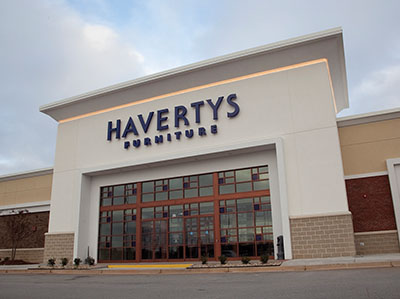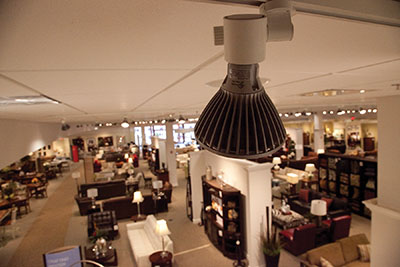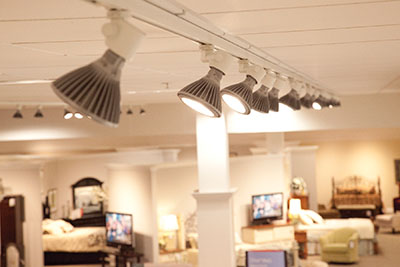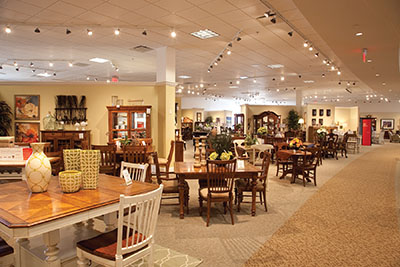How Havertys Furniture saved up to $22,300 per store with a stylish 14-watt solution.

LED lighting is reshaping retail facilities across America. From furniture outlets to supermarkets to department stores, the secret is out about energy-efficient LED technology. For merchandisers, the rewards of a lighting swap or new installation can be many: energy costs reduced thousands of dollars a month; enriched shopping environments optimizing crisp, white light; lighting efficiency rebates for each LED lamp installed; heightened security in parking lots and near buildings; and virtually no maintenance for many years.
Facility owners must weigh this bevy of possible benefits against the initial purchase cost of an LED system, just as Havertys Furniture did when evaluating its lighting portfolio across all 120 of its Southeast-region locations. From questions about the quality of LED lighting to understanding lighting as a key component of an enterprise-wide energy-management strategy, the company faced many considerations and charted a course that others in search of their own LED lighting solution can navigate by.
Set the Standard
Established in 1885 in downtown Atlanta, Havertys today serves millions of customers in 17 states. The company has always explored new and creative ways to lessen its environmental impact, including a recent $180,000 investment in equipment that recycles approximately 4,000 tons of corrugated cardboard and approximately 800 tons of plastic and Styrofoam® each year.
Havertys wanted an indoor LED lighting solution that would reduce its energy footprint while benefiting the bottom line as well as the look of its stores, many newly re-branded. The retailer — having an already keen eye for the right light for every room in the house — set strict standards for its new lamps including specific wattage, CRI and lumen level requirements. Several executives also expressed concern that LED illumination could ever match the color and consistency of halogen and incandescent lighting, long utilized throughout Havertys’ stores.
 Get Audited
Get Audited
Following an evaluation of competitive lighting products, Havertys selected a 14-watt LED PAR38 lamp to retrofit existing stores and for new construction moving forward. A lighting audit revealed Havertys was paying approximately $36 to power a single 90-watt halogen bulb for 1 year, based on 4,000 hours of operation and a $0.10 kilowatt hour (kWh) rate. By comparison, it would cost just $5.60 to light each LED lamp for the same period of time.
A professional lighting audit is a sure first step for retailers eager to learn more about smarter facility management. Today many electrical products wholesalers/distributors, utility companies and independent lighting experts offer such onsite analysis, typically at little to no cost and without obligation to a particular product manufacturer.
In that the decision to “change one bulb with another” is never so simple, a lighting audit can offer both reassurances about the “new look” of the store and present a clear picture of immediate and eventual energy and maintenance gains — just as when Havertys discovered it would no longer need to replace halogen bulbs at least once a year in stores where new LED lamps with a 25,000-hour rated life were installed.
Such an assessment can also spur a reimagined lighting system that rearranges existing fixtures and/or incorporates new installations — the visual impact being greater than what could be achieved by changing bulbs alone, while still at considerably less cost than a new system altogether. In still other cases, an audit may uncover the opportunity to eliminate a number of fixtures entirely, meaning greater savings potential for facility owners.
 Shop Selectively
Shop Selectively
LED technology has evolved rapidly over the past decade to offer retailers an ever-expanding selection of lamps and fixtures for lighting everything from the sales floor to merchandise counters to refrigerated display cases to parking lots to signs inside and out. High-efficiency and high-power LEDs are illuminating commercial settings the world over as continual innovation produces higher quality light comparable — and increasingly preferable — to familiar incandescent and halogen sources.
This means facility managers need not be satisfied with just any LED lighting solution. It is not uncommon that a thorough evaluation of numerous options last a year or longer. Your trusted lighting advisor can help you discern the differences between bulbs and is an expert at matching your preferences for brightness, color and temperature to the product best suited to your sales environment.
For Havertys it was important that the LED diodes would not be visible on its new lamps, as exposed LEDs tend to appear as ‘dots’ in reflective surfaces — both a distraction to customers and a detriment to the fine shopping experience the company strives for.
Citing the combined “technology, performance and aesthetics” of the LED PAR38 lamps in its decision to move forward with new lighting, Havertys made special note of the lamps’ Visual Comfort Lens™, calling it “a game-changer.” The LED diode mounting locations and design of the Visual Comfort Lens work in tandem to evenly diffuse light, helping retailers like Havertys achieve a halogen-like contrast while avoiding unsightly glare or ‘points’ of light on merchandise.
Havertys also found the right lumen output with this LED solution: the new lamps showcase the wood grain and fabrics of home furnishings without being overpowering. And where concerns remained about the quality of LED lighting, Havertys’ executives, upon seeing how the lights performed, agreed the LED lamps actually illuminate merchandise better than old halogen and incandescent sources.
Present the Big Picture
In addition to new indoor LED lighting, Havertys is implementing other energy-efficient HVAC and whole-building system measures at many of its stores to further drive down costs and shrink its energy footprint. HVTerra, Havertys’ environmental stewardship program, aims to achieve an enterprise-wide 25% energy reduction by the end of 2013 compared to measures set in 2008. To date, the company reports an overall 21% reduction in electricity usage.
“Our goal is to integrate profit, people and environmental accountability in all we do,” says Rawson Haverty, Jr., senior vice president of real estate for Havertys. “Our HVTerra strategy is not only about doing the right things, but also increasing a real competitive advantage as well as new business opportunities.”
 Share your ambitions for an integrated energy management system with your lighting advisor. There are many avenues to additional savings, including lighting control systems with occupancy-sensing and dimming capabilities that can easily curb undue energy consumption. Some advanced lighting controls can even be integrated with other building automation systems to respond accordingly to changing electrical loads throughout the day, further optimizing energy use.
Share your ambitions for an integrated energy management system with your lighting advisor. There are many avenues to additional savings, including lighting control systems with occupancy-sensing and dimming capabilities that can easily curb undue energy consumption. Some advanced lighting controls can even be integrated with other building automation systems to respond accordingly to changing electrical loads throughout the day, further optimizing energy use.
With the implementation of new LED lighting as an element of its own integrated energy management strategy, Havertys’ Fairfax, Virginia, store showed a 65% reduction for June 2012 compared to June 2011 — attributable to the combination of new high-efficiency LED lighting and a new high-efficiency HVAC system.
Among stores retrofit with new LED lighting only, Havertys reports a 25% to 35% energy reduction — its Austin, Texas, location alone seeing a more than 40% decrease.
Accelerate ROI with Rebates
While Havertys did not apply for a lighting efficiency rebate to help with the cost of its own LED conversion, such incentive programs are widely available on behalf of electric utility companies and state agencies. Look again to your expert advisor to steer you to opportunities to earn cash back for every LED lamp installed. An experienced partner can also help clue you in to the complexities of the rebate application process that can be lengthy and laden with detailed documentation.
Find Favorable Financing
Perhaps the biggest question a facility owner will face is how to fund an LED lighting investment that can range from tens to hundreds of thousands of dollars depending on the size of the project. Again there are many options available to those who know where to look. From programs that apply monthly energy savings to the purchase cost of the LED product to special financing that can create a cash-flow positive position from day one, take time to investigate arrangements through your local lighting services provider, financial institution and/or preferred product manufacturer.
By any means, the end result of an LED lighting upgrade is substantial savings more often than not. Havertys stands to slash lighting costs by as much as $22,300 a year at stores that have made the switch to new LED lighting. Projected over 10 years across multiple locations, it’s easy to understand the broad scope of Havertys’ total savings potential.
— Ryan Rodau is a retail vertical manager with GE Lighting, which sells products under the Reveal® and Energy Smart® consumer brands, and Evolve™, GTx™, Immersion ™, Infusion™, Lumination™ and Tetra® commercial brands. To learn more about energy-saving LED lamps for enriching retail environments, please visit www.gelighting.com.
